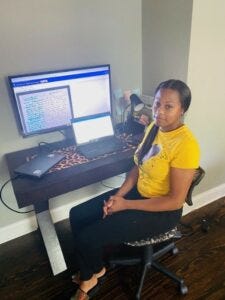March 29, 2022 by Megan Harris
Part of the suite of interpretive resources released earlier this month focusing on letters in the VHP archive, this online exhibit came to life a bit differently than others on our list.
LC staff member Candace Milburn at her bedroom work station during the Covid-19 pandemic, June 2020. Photo courtesy of Candace Milburn.
In the spring of 2020, Library of Congress staff members left our Capitol Hill campus to isolate at home due to COVID-19 safety protocols. For many of us, this transition to telework was a fairly easy process. Once we worked out the kinks of remote connections and video conference etiquette, we could resume our normal day-to-day operations with just a few hiccups here and there. But for many others—those staffers whose work requires in-person access to collection materials—telework presented a huge challenge. How could these colleagues contribute to our mission-critical activities with little or no access to physical collections?
One of the many creative solutions to this problem was the establishment of VHP’s ongoing program of transcribing correspondence collections. Transcription is such a laborious process that up until recently, VHP has not had the time or resources to transcribe collection materials (whether they are manuscripts or oral histories). While VHP has a vast array of digitized letter collections in our archive, prior to the pandemic, very few of them featured transcripts.
Rare though they are, transcripts can be a lifesaver for researchers and those interested in reading correspondence collections, exponentially increasing the accessibility of the contents. Anyone who has squinted their eyes trying to decipher a vintage letter knows how hard it can be to interpret handwritten material. Our modern eyes are accustomed to reading typewritten or printed words, and not those written in cursive script. In the case of VHP materials, many of the letters in our archive were written under less-than-ideal conditions, often making them even harder to read. Servicemen and women would frequently compose their correspondence in foxholes and leaky tents, aboard trains and tempest-tossed ships—and their handwritten letters sometimes reflect these rough conditions. Add to it the inherent degradation of decades of wear and tear, and it’s a wonder that these letters are legible at all!
Screenshot of a transcribed letter from the Ewing Miller II collection, showing the original letter beside the transcript. Ewing Miller II Collection, Veterans History Project, AFC2001/001/102421.
That’s why VHP’s pandemic transcription efforts have been so valuable. Over the last two years, staff members working from home have transcribed over 5,000 letters in over 50 different VHP collections. Many of these collections included hundreds of letters—the Andrew Del Regno Collection almost 600! We chose nine of these collections to include in Line by Line, to offer readers a taste of what transcribed collections have to offer.
On each veteran’s digitized collection page, the transcripts are situated alongside the original letters; readers can view the original letter while simultaneously reading through the transcript. This mode of presentation maintains the integrity and distinctiveness of the original letter without demanding that the viewer stumble through deciphering each and every word. Having access to these side-by-side transcripts means that readers can focus on the contents of the letter rather than on interpreting the quirks of a veteran’s handwriting.
And the content of these letter collections is riveting: by turns poignant and heart-wrenching, humorous and eye-opening. You might chuckle over Edward Zahler’s jocular exchanges with his sister, and glimpse his anxiety over the fate of his kid brother, Donald, who was also serving. Perhaps you’ll be drawn to John Carson’s dry wit, evident throughout his missives to his parents. Or you can take a look at Henry Walker McIver’s letters, which all begin with a detailed, evocative pen-and-ink sketch illustrating his text.
“Letter to Folks [March 10, 1944].” Henry Walker McIver Collection, Veterans History Project, Library of Congress, AFC2001/001/67942.
All of these letter collections illustrate the power of personal correspondence as a primary historical resource. Though they originally functioned as a means of reassuring loved ones and providing the writer with a momentary escape from the desolation of wartime conditions, these letters now personalize and contextualize larger historical events. You may think of D-Day a bit differently after reading Ellsworth Hill’s account of it in a letter to his family.
We hope you enjoy browsing through the featured collections, line by line. Many thanks to Tamika Brown, Yvonne Brown, Glenn Ferrara, Rachel Frederick, Jordan Kearschner, Laura Kells, Helen McNamara, Candace Milburn, Sarah Mitrani and Justina Moloney for all of their hard work in making these letter collections more accessible.
For more blog posts detailing VHP staff activities during the pandemic, see our blog series Working Together Apart, with posts authored by Tamika Brown, Yvonne Brown, Tracey Dodson, Andrew Huber, Candace Milburn, and Justina Moloney.

